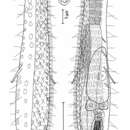Description
(
anglais
)
fourni par Zookeys
Adult Lt 271–344 µm; LPh 102 µm to PhJIn at U39–U30 (Fig. 14). Body length medium, ventrally flattened, dorsally vaulted; head end bluntly rounded, bearing club-shaped, ear-like pestle organs at U04; body narrows along the hind-pharyx; trunk broadens along the mid-gut, narrowing gently to the caudal base; caudal pedicles of medium length (L 22 µm) borne on lobes, with a sharply concave margin separating the two lobes, indenting medially to U94. Widths at pestles /neck /mid-gut /caudal base, and locations along the length of the body are as follows: 48 /38 /56 /26 µm at U04 /U19 /U64 /U96, respectively. Glands 37 per side, 20 (2 µm diameter to 9 × 5 µm) scattered in lateral columns at U13–U87 and 16–17 (5 µm diameter to 9 × 5 µm) scattered in medial columns at U11–U92.
Cuticular armature: Epidermis armored with tetrancres (L 7 W 5 µm) that are of much the same size over much of the body (Fig. 14 B), though somewhat smaller fore and aft; ancres cover dorsal and lateral surfaces in some 36–38 rows of 13–15 ancres each, being absent from the oral hood, but extending the length of the caudal lobes.
Adhesive tubes: TbA 5 per side (L 9 µm), forming a transverse arc, the medial-most differing in shape from the others, all tubes inserting directly on the postoral body surface at U07–U08, radiating from forward to obliquely outward. TbVL 12 per side, 1 in the fore pharyngeal region (L 6 µm) at U10 inserting just behind the TbA, 4 of similar size and spacing along the fore-gut (L 10 µm) at U36–U58, and 7 located at and behind the anus (L 10 µm) closely spaced at U91–U96, the last 3 inserting beneath the caudal lobe; TbV 3 per side (L 10 µm) in a transverse row at U87; TbDL 2 per side at U51 (L 26 µm) and U90 (L 17 µm); TbP 3 per side on the caudal pedicles, forming the fused ‘two fingers and a thumb’ typical of the family, (L terminal tubes 8 µm, L tube on the inner margin 6 µm), not supplemented by a blind cirrata-like structure projecting dorsoposteriorly from between the ‘fingers, ’ and with no additional tubes in the space between the peduncles.
Ciliation: Many short sensory cilia surround the oral opening (L 6–9 µm), with a number along the fore end of the oral hood (L 10–18 µm) and several laterally (L 12–15 µm) before the pestle organs; other cilia occur regularly along the lateral (L 10–40 µm) and dorsolateral (L 22–40 µm) body surfaces, numbering 12 and 18 per side, respectively. Ventral locomotor ciliature forms a single field of transverse rows from TbA to anus, lying between the TbVL columns, the field narrowing from anus to caudal base; individual cilia are 8–10 µm in length.
Digestive tract: Mouth subterminal, as broad as the fore end of the body (32 µm width); oral hood extends from U00 to U03; buccal cavity is lightly cuticularized;pharynx has inconspicuous basal pharyngeal pores; intestine narrows gradually front to rear; anus is ventral at U87.
Reproductive tract: Hermaphroditic, testis on right side as seen from above (left side as seen from below); vas deferens appears to open into the caudal organ, just before the anus; The largest developing ovum (up to 94 × 37 µm) occurs above the foregut, with ovules bilaterally to the rear; caudal organ large, longitudinally ovoid and thick-walled (47 × 19 µm), with an interior of refractive material and a central canal; frontal organ transversally ovoid and hyaline, often bears active sperm.
- licence
- cc-by-3.0
- droit d’auteur
- William D. Hummon
- citation bibliographique
- Hummon W (2011) Marine Gastrotricha of the Near East: 1. Fourteen new species of Macrodasyida and a redescription of Dactylopodola agadasys Hochberg, 2003 ZooKeys 94: 1–59
- auteur
- William D. Hummon
Distribution
(
anglais
)
fourni par Zookeys
Geographical distribution: RED SEA: EGYPT {23km S Ein Sukhna, Sharm el-Arab Outside, Wadi ’Araba [video], Daghashland, Giftun Island SE [2-videos], Giftun Island SS, ^Giftun Village Spit Outside [cdom] (27°10'N, 33°49'E) [4-videos], Hammam Pharaon, Nabq S [video], Ras Nasrani}.
- licence
- cc-by-3.0
- droit d’auteur
- William D. Hummon
- citation bibliographique
- Hummon W (2011) Marine Gastrotricha of the Near East: 1. Fourteen new species of Macrodasyida and a redescription of Dactylopodola agadasys Hochberg, 2003 ZooKeys 94: 1–59
- auteur
- William D. Hummon

